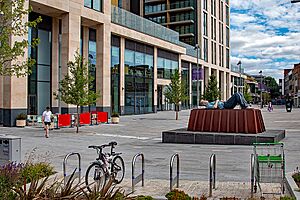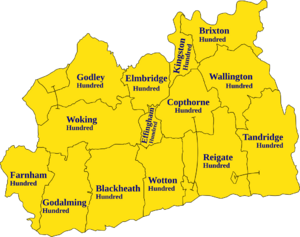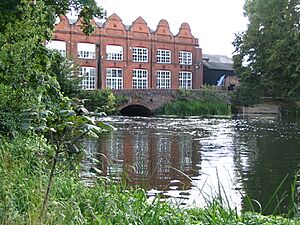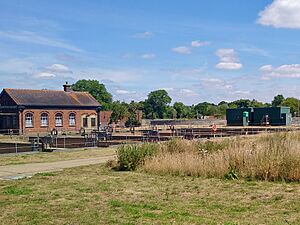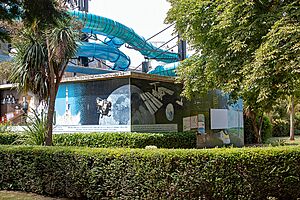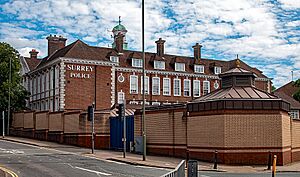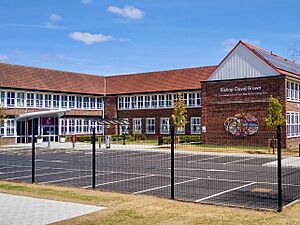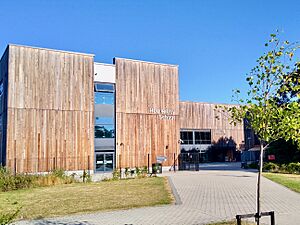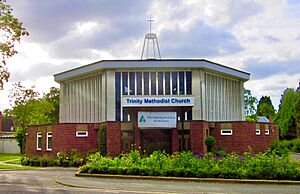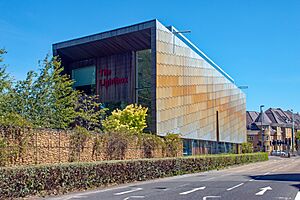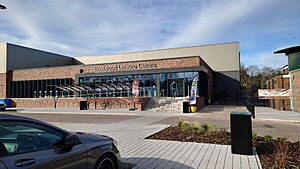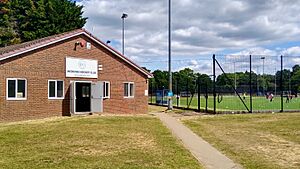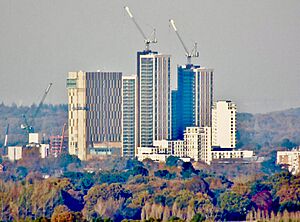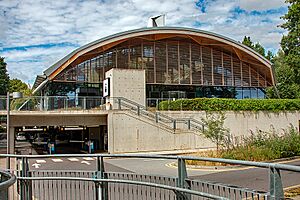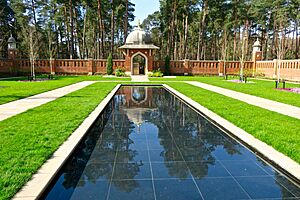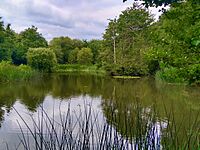Woking facts for kids
Quick facts for kids
Woking
Borough of Woking |
|
|---|---|
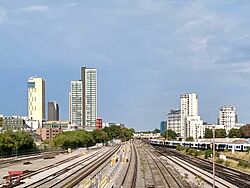
Woking town centre from the west
|
|
| Motto(s): | |
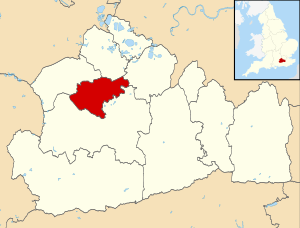
The Borough of Woking in Surrey
|
|
| Sovereign state | United Kingdom |
| Constituent country | England |
| Region | South East England |
| Non-metropolitan county | Surrey |
| Status | Non-metropolitan district |
| Admin HQ | Woking |
| Incorporated | 1 April 1974 |
| Government | |
| • Type | Non-metropolitan district council |
| • Body | Woking Borough Council |
| Area | |
| • Total | 24.6 sq mi (63.6 km2) |
| Area rank | 259th (of 326) |
| Population | |
| • Total | 103,900 (estimated) |
| • Rank | 240th (of 326) |
| Ethnicity (2021) | |
| • Ethnic groups |
List
|
| Religion (2021) | |
| • Religion |
List
47.6% Christianity
33.3% no religion 9.4% Islam 5.8% not stated 2.4% Hinduism 0.6% Buddhism 0.5% other 0.3% Sikhism 0.2% Judaism |
| Time zone | UTC0 (GMT) |
| • Summer (DST) | UTC+1 (BST) |
| ONS code | 43UM (ONS) E07000217 (GSS) |
| OS grid reference | TQ0040358550 |
Woking is a town and borough in northwest Surrey, England. It is about 23 kilometers (14 miles) from central London. The town's name, first seen as Wochinges in the Domesday Book, likely comes from an old Saxon landowner. The earliest signs of people living here date back to the Paleolithic (Stone Age).
Woking became a modern town in the mid-1860s. This happened when the London Necropolis Company started selling land near the railway station for new homes. Today, the Borough of Woking covers about 64 square kilometers (25 square miles) and had a population of 103,900 in 2021. Many parts of the borough are protected as Metropolitan Green Belt, which limits new building.
The town center of Woking is mostly new, built in the 20th and 21st centuries. But there are also many historic buildings nearby. These include the old Woking Palace, once a home for kings like Henry VII and Henry VIII. St Peter's Church in Old Woking has parts from the time of William I. The Shah Jahan Mosque, built in 1889, was the first building made specifically for Muslim worship in the UK. Woking is also famous for its connection to author H. G. Wells, who wrote The War of the Worlds while living here.
Contents
- Exploring Woking's Geography
- Woking's Rich History
- Woking's People and Homes
- Woking's Economy and Jobs
- Public Services in Woking
- Getting Around Woking
- Learning in Woking
- Places of Worship
- Woking's Culture and Arts
- Sports and Recreation
- Important Buildings and Landmarks
- Parks and Green Spaces
- Famous People from Woking
- See also
Exploring Woking's Geography
The Borough of Woking is located in northwest Surrey. The main town of Woking is surrounded by smaller communities. These include West Byfleet and Byfleet to the east, and Knaphill to the west. Villages like Brookwood and Mayford also keep their own unique feel.
About 60% of the land in the borough is part of the Metropolitan Green Belt. This means it is protected from being built on, which helps keep the area green. There are also six Sites of Special Scientific Interest here. Five of these are areas of heathland, and one covers most of the Basingstoke Canal.
Woking Town Centre Today
Woking town centre is about 23 kilometers (14 miles) from central London. It covers an area of about 50 hectares (124 acres). The main shopping and office areas are located between the railway line and the Basingstoke Canal. The two main shopping centers, The Peacocks and Wolsey Place, are next to Jubilee Square. A new public space, Victoria Square, was finished in 2022. This project also included two tall apartment buildings and a 23-story hotel.
Old Woking: The Original Settlement
Old Woking is about 1.6 kilometers (1 mile) south of the town centre, near the River Wey. This is where the original settlement of Woking began. The village likely grew around St Peter's Church, which has parts dating back to the 11th century. Old Woking has expanded over time and is now connected to the main urban area.
Rivers and Geology
Most of the borough is drained by the River Wey. This river flows along the southeastern edge of the area. The Hoe Stream also flows through Mayford and joins the Wey. The Basingstoke Canal runs from west to east. Major floods have happened in Woking in 1968, 2000, 2014, and 2016.
The ground beneath Woking was formed in the Cenozoic era. Sandy Bagshot Beds are found around the town centre. To the west, around Knaphill, are the Bracklesham Beds, which have more clay. This clay was historically used for making bricks.
Woking's Rich History
Early Times and Ancient Finds
The oldest signs of people in Woking are from the Stone Age. Flint tools from about 13,000 years ago have been found in Horsell. Knife blades from about 12,000 to 11,000 years ago were found in Pyrford. Two ancient burial mounds, called bell barrows, and a disc barrow on Horsell Common are from the early Bronze Age. These mounds suggest the area was mostly open heathland back then.
During the Roman period, people lived in Old Woking and Mayford. They likely worked with iron and made pottery. Roman tiles can even be found in the tower of St Peter's Church.
The first written record of Woking mentions a religious site in the early 8th century. Woking was an important administrative center for northwest Surrey. By 775, there was a minster (a type of church) in Woking, which might have been the start of St Peter's Church. Later, Woking became a royal village. Towards the end of the Saxon period, Surrey was divided into areas called hundreds, and Woking was one of them.
How Woking Was Governed
In the Domesday Book of 1086, Woking was called Wochinges. It was partly owned by William I (William the Conqueror). Woking was one of the larger settlements recorded in the country at that time.
Woking was owned by the Crown (the King or Queen) until 1189. Over the centuries, it passed through different noble families. In 1466, it was given to Lady Margaret Beaufort, who was the mother of the future Henry VII. When she died in 1509, her grandson, Henry VIII, inherited Woking.
Local government changed over time. In the Tudor period, local churches (vestries) managed daily town affairs. They appointed police, helped the poor, and fixed roads. Later, Justices of the Peace took on more responsibility for law and order.
In 1893, Woking got its own local board, which became the Urban District Council (UDC) in 1894. Woking UDC grew in size in 1907 and 1933, taking in nearby parishes like Horsell, Byfleet, and Pyrford. Woking officially became a borough in 1974. Today, 30 elected representatives serve on the council, each for four years.
Transport and Travel

The River Wey was used for transport long ago. In 1651, the River Wey Navigation was built. This project added 12 locks and 9 kilometers (5.6 miles) of new cuts between the River Thames and Guildford. Three of these locks are in Woking.
The Basingstoke Canal was built to transport goods from Hampshire to London. It opened in 1794. A wharf was built at Horsell for local farmers. Bricks were also made in Woking and sent to London using the canal. However, the canal became less important after the railway opened. It was restored in 1991 and is now used for recreation.
The London and Southampton Railway opened in 1838, with the first train running to Woking. Woking station was initially surrounded by open land, but it quickly became a major transport hub for west Surrey. The station became a junction in 1845 when a branch line to Guildford opened. Other stations in the borough include Brookwood, Worplesdon, and West Byfleet.
The London Necropolis Company was created in 1852 to build Brookwood Cemetery. This was because burials were banned in central London. The company bought a large area of land in Woking for the cemetery. Coffins were transported to Brookwood by special funeral trains until 1941.
How Woking Grew
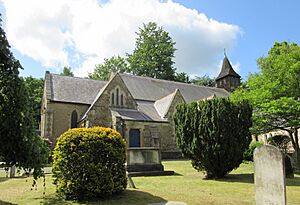
New homes started to be built in St John's in the early 1800s. This area grew because of a new wharf and brickworks. A chapel was built in the 1830s, which was later replaced by a larger church in 1842. The area then became known as "St John's."
Modern Woking began to develop from the 1860s to the 1880s. The London Necropolis Company sold off extra land not needed for Brookwood Cemetery. The High Street was laid out by 1863, and the first houses appeared on streets like Ellen Street (now West Street). Later, the company developed Hook Heath for large, detached houses and even built a golf course to attract residents.
After the First World War, the first council housing was built in Woking. By 1921, about 100 families had moved into new homes. More houses were built in the following decades. After the Second World War, new housing estates were built in areas like Maybury and Sheerwater.
Today, many Victorian buildings in the town centre have been replaced. The council now allows tall residential buildings in the town centre, like the two towers in the Victoria Square project. Old industrial sites are also being turned into homes, such as the Gresham Mill apartment complex.
Woking's Businesses and Industries
Until the mid-1800s, Woking's economy was mostly farming. However, much of the land was not very fertile. New laws allowed landowners to use land for pasture and crops.
The Basingstoke Canal helped new industries grow. Brickmaking expanded in Knaphill. Nurseries also started to grow ornamental garden plants, like the famous Clematis varieties 'Jackmanii' and 'Belle of Woking'. By 1900, growing plants was a very important industry.
During the First World War, heavy industry came to Woking. The Martinsyde Aircraft Works opened, producing over 600 biplanes. After the war, the factory closed. In 1926, James Walker's company, which made packaging materials, bought the site. It became Woking's largest employer.
The Sorbo Rubber Works opened in 1920, making rubber sponges and toys. During the Second World War, they made self-sealing aircraft fuel tanks for the Royal Air Force.
Woking has a history of breweries. The first known brewery opened in Old Woking in 1715. Today, the UK headquarters of Asahi Breweries, a large brewing company, is in Woking.
The McLaren Group, famous for its Formula One team and luxury cars, was founded in 1981. Their headquarters, the McLaren Technology Centre, opened in Woking in 2004. McLaren was the largest employer in the borough in 2013.
Woking During World War II

During the Second World War, Woking's defense was managed by the local Home Guard. They trained at Mizens Farm and guarded important sites like the power station and factories. Air raid shelters were built for safety.
Woking was a target for bombing because of its railway junction and Vickers aircraft factories. The worst attack was in January 1941, killing seven people. By the end of 1944, Woking had 58 air raids, damaging many homes. The last bomb, a V-2 rocket, fell on March 2, 1945.
Woking's People and Homes
In 2021, Woking's population was 103,900. The 2011 Census showed that most residents were white (83.6%), with 11.6% of Asian descent.
Woking has a large Italian community, many from the town of Mussomeli in Sicily. They often worked in factories or mushroom farms, and some started their own businesses. St Dunstan's Catholic Church even holds services in Italian. There is also a large Pakistani population, mainly in Maybury and Sheerwater.
| Area | Population | Households | Owned outright | Owned with a loan | Social rented | Private rented |
|---|---|---|---|---|---|---|
| Borough of Woking | 79,185 | 40,964 | 31.6% | 38.9% | 11.9% | 15.7% |
| South East Region | 8,634,750 | 3,555,463 | 35.1% | 32.5% | 13.7% | 16.3% |
| Ward | Detached | Semi-detached | Terraced | Flats and apartments |
|---|---|---|---|---|
| Borough of Woking | 32.1% | 24.3% | 19.5% | 24.8% |
| South East Region | 28.0% | 27.6% | 22.4% | 21.2% |
Woking's Economy and Jobs
Woking has a strong economy compared to the rest of the UK. In 2021, it was ranked first in a UK economic vitality index. Many residents (over 60%) have university degrees. However, about 53% of working residents travel outside the borough for their jobs.
In the mid-2010s, the biggest job providers were information technology, food and beverage services, and car design and manufacturing. Woking also has many companies in the oil and gas, finance, and environmental technology sectors.
In 2023, a government review showed that Woking council had significant debts. This was due to investments in hotels and skyscrapers. The council is now being overseen by expert commissioners to help fix its financial challenges.
Public Services in Woking
Utilities for Homes and Businesses
Woking Gas and Water Company started supplying drinking water in 1883. By 1895, Horsell and Pyrford were connected to Woking's water supply. Today, Affinity Water supplies water to the area.
As Woking grew, a sewage works opened in 1896. Sewers were laid in the town centre by 1899. A separate sewage works was built at Wisley for Byfleet and Pyrford.
The public gasworks opened in 1892. Gas mains were laid to Horsell and West Byfleet by the late 1890s. By 1935, the Woking District Gas Company supplied over 9,000 customers.
Woking Electric Supply Company started in 1889. Electric streetlights were installed in Woking in 1893. In 1926, Woking was connected to the National Grid.
Since the 1990s, Woking council has invested in renewable energy. This includes combined heat and power plants, solar panels, and a hydrogen fuel cell at Woking Park. The council aims to generate more electricity from renewable sources in the future.
Emergency Services and Safety
The first fire brigade in Woking was formed in 1895. In 1899, the council bought its first horse-drawn fire engine. Today, Surrey Fire and Rescue Service is responsible for fire services. Ambulance services are provided by the South East Coast Ambulance Service.
At the end of the 19th century, Woking had a small police force. By 1908, it had grown to 31 officers. Today, Surrey Police is responsible for policing in the borough. They have a front counter at Woking Civic Offices.
Healthcare in Woking
Brookwood Hospital was founded in 1867 as a psychiatric hospital for west Surrey. It became part of the NHS in 1948 and closed in 1994.
The first general hospital in Woking opened in 1893. It was called Victoria Cottage Hospital. It grew over time, but closed in 1993.
Woking Community Hospital, on Heathside Road, has a walk-in centre for minor injuries and a rehabilitation ward. The Bedser Hub helps older people stay independent. The nearest hospitals with an A&E department are St Peter's Hospital, Chertsey, Royal Surrey County Hospital, and Frimley Park Hospital.
Getting Around Woking
Woking has good transport links to London and the wider South East. It is connected to major motorways like the M25 and M3. However, road connections to nearby towns in northwest Surrey are not as good.
Woking railway station is managed by South Western Railway. Trains run to London Waterloo, Southampton Central, Alton, and Portsmouth Harbour. South Western Railway also runs services from Brookwood, Worplesdon, and West Byfleet stations.
Buses connect Woking town centre to surrounding areas. A RailAir coach service links Woking station to Heathrow Airport.
The River Wey is navigable from Weybridge to Godalming. The Basingstoke Canal is also open for boats when water levels allow.
National Cycle Network Route 221 runs alongside the Basingstoke Canal. Route 223 passes through Woking. The "Planet Trails" are 21 off-road cycle routes in Woking. They celebrate the town's connection to The War of the Worlds by H. G. Wells, with each route named after a planet or moon. A crater on Mars was named after Woking in 2006.
The Fox Way, a 63-kilometer (39-mile) footpath around Guildford, passes through the south of the borough. The E2 European long distance path runs along the River Wey Navigation.
Learning in Woking
Early Schools
The oldest record of a school in Woking is from 1725 in Byfleet. At that time, there was also a "poor writing master" in Woking. Younger children went to dame schools to learn to read. National schools were set up in Pyrford in 1847 and Old Woking in 1848.
Current Schools and Colleges
The Winston Churchill School is a mixed school for ages 11 to 16. It opened in 1967. Its planetarium was opened in 2019 by former student and actor, Peter Davison. The planetarium is also open to the public.
The St John the Baptist School is a mixed Catholic school for ages 11 to 18. It became an academy in 2016.
Woking High School was founded in 1970. It became an academy in 2013 and teaches students aged 11 to 16.
The Bishop David Brown School, in Sheerwater, is a mixed academy for ages 11 to 16. It was formed in 1982.
Hoe Valley School opened in 2015 and moved to its current site in 2018. It teaches children up to age 16, with a sixth form opening in 2023.
Woking College, for ages 16–19, opened in 1977. It became an academy in 2017. The college received funding to build a new teaching block, allowing more students to enroll.
The Gordon Ramsay Academy opened in 2021. This site was previously the Tante Marie Culinary Academy, a cooking school founded in 1954.
Places of Worship
Christian Churches
Many Church of England churches in Woking are listed, meaning they are historically important. Three are Grade I listed.
St Peter's Church, Old Woking is the oldest building in the borough. It may have had a wooden church during the Saxon period, replaced by a stone building after the Norman Conquest. The Church of St Mary the Virgin in Byfleet dates from the 13th century. St Nicholas' Church in Pyrford, from the 12th century, has old Medieval wall paintings.
The Church of St Mary the Virgin at Horsell was built in the mid-12th century. It is known for its oak pulpit from 1602. Other listed churches include Christ Church, All Saints, St Mary of Bethany, and St John the Baptist.
The first Catholic church in Woking was built in Sutton Park in 1875–76. The current St Dunstan's Church opened in 2008.
The first Methodist chapel opened in 1863. A larger Methodist church was built in 1905. Today, Trinity Methodist Church, opened in 1965, is in the town centre.
There are two Baptist churches: Knaphill Baptist Church (built 1882) and New Life Baptist Church (started 1929).
Other Religions
The Shah Jahan Mosque was the first purpose-built mosque in the UK. It was built in 1889. It has an onion dome and four turrets. The mosque closed in 1899 but reopened in 1912.
The Woking Buddhist Temple at Knaphill is one of 15 Thai Buddhist temples in England. It is the headquarters of the Dhammakaya Movement. A Meditation Garden opened there in 2021.
Woking's Culture and Arts
Literature and Famous Authors
Much of The War of the Worlds by H. G. Wells takes place in Woking. Wells wrote most of the novel while living in Maybury Road from 1895 to 1898. In the story, a Martian spaceship lands on Horsell Common. A bronze statue of Wells was put up in Woking town centre in 2016. There is also a 7-meter (23-foot) tall sculpture of a Martian Tripod from the book.
Woking is also mentioned in Sir Arthur Conan Doyle's Sherlock Holmes story "The Adventure of the Naval Treaty".
Local Media
The Woking News and Mail newspaper was first published in 1894. It closed in 2011 but was restarted by a local businessman. Weekly editions began again in 2012.
Music Scene
The band The Jam formed in Woking in the early 1970s. They started performing in local clubs. Their 1982 hit "Town Called Malice" describes growing up in Woking. Lead singer Paul Weller named his 1995 album Stanley Road after his childhood street.
Other musicians from Woking include Rick Parfitt of Status Quo and songwriter Les Reed, who wrote songs for Tom Jones. The Spice Girls started their dance rehearsals at Trinity Studios in Knaphill, now the Woking Youth Arts Centre.
Public Art Around Town
Woking has many public art pieces. These include colorful statues by local sculptor Sean Henry. On the Bedser Bridge, there are statues of cricketing brothers Sir Alec and Eric Bedser by Allan Sly. The Winning Shot by Christine Charlesworth shows wheelchair basketball player Ade Adepitan, celebrating the London 2012 Paralympic Games.
Entertainment Venues
The Ambassadors Theatre Complex opened in 1992. It has two theatres: the 1,300-seat New Victoria Theatre and a smaller 230-seat studio theatre, the Rhoda McGaw Theatre.
The Ambassadors' Cinema opened in 1993. It closed for renovations in 2019 and reopened as Nova Cinema in 2021 with seven screens.
The Lightbox, an arts and heritage centre, opened in 2007. It has a museum of local history and hosts art exhibitions. The first Woking Literary Festival was held there in 2017.
Sports and Recreation
Leisure Centres and Pools
Woking Leisure Centre opened in 1976. It has a gym and facilities for badminton, basketball, and five-a-side football. It was refurbished in 2013. Other centres include Woking Sportsbox (opened 2018) and Eastwood Leisure Centre (opened 2021).
Before 1910, people swam in the canal and River Wey. The first open-air pool opened in Woking Park in 1910. It was replaced by Woking Lido in 1935, and then by Pool in the Park in 1989. New water slides, "The Martian" and "The Time Traveller," opened in 2019. Eastwood Leisure Centre has a 25-meter main pool and a teaching pool.
Football in Woking
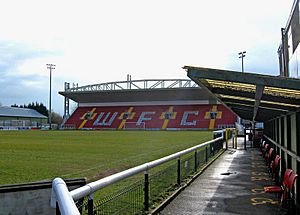
Woking F.C., nicknamed "the Cardinals," was formed in 1887. They play their home games at Kingfield Stadium. The club won the FA Amateur Cup in 1958 and the FA Trophy three times (1994, 1995, 1997). As of the 2024/25 season, they play in the National League, the fifth tier of English football.
The borough also has three other football clubs: Westfield F.C., Sheerwater F.C., and Knaphill F.C..
Cricket Clubs
Pyrford Cricket Club was founded in 1858. Westfield Saints Cricket Club started in 1875.
Byfleet Cricket Club was founded in 1876 and plays at its club ground in Parvis Road. Woking and Horsell Cricket Club started in 1905. Old Woking Cricket Club was founded in 1962.
Hockey and Rugby
Woking Hockey Club was founded in 1904. It is based at Goldsworth Park and has two AstroTurf pitches. The Hockey Museum opened in Woking in 2012.
Woking Rugby Football Club (R.F.C.) started as Vickers R.F.C. in 1931. It was reformed under its current name in 1990 and plays at the Byfleet recreation ground.
Important Buildings and Landmarks
War Memorials
Old Woking War Memorial was unveiled in 1920 in St Peter's Churchyard. It is a granite wheel cross remembering those who died in the world wars.
The Woking War Memorial was unveiled in 1922 and moved to Jubilee Square in 1975. It is a sandstone column with a statue of Victory. It lists the names of 520 people who died in the First World War.
Byfleet War Memorial is a stone cenotaph that lists the names of 72 people who died in the First World War and 14 from the Second.
Woking Palace Ruins
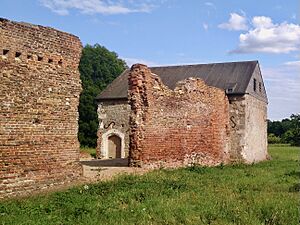
The first manor house at Woking Palace was likely built around 1189. It was a large building that could hold many guests. Lady Margaret Beaufort, mother of Henry VII, lived there.
Kings Henry VII and Henry VIII often visited and made improvements, adding a new kitchen and royal apartments. However, James I lost interest, and the palace fell into disrepair. Today, only the perimeter moat, former fishponds, and one stone building remain.
Other Notable Buildings
The tallest buildings in Woking are Victoria Square Tower 1 (104 meters/341 feet) and Tower 2 (98 meters/322 feet). These buildings contain apartments. Tower 3, a 23-story building, has a Hilton Hotel.
Export House, completed in 1974, is 73 meters (240 feet) tall. It is known as "The BAT Building" and has peregrine falcons nesting on top.
Woking Crematorium, opened in 1885, was the first purpose-built crematorium in the UK.
The Living Planet Centre, opened in 2013 by David Attenborough, is the headquarters of the UK World Wide Fund for Nature. It has a Learning Zone for visitors.
The Surrey History Centre, opened in 1999, houses historical collections from Surrey.
Sutton Place, built around 1525, is one of England's earliest unfortified houses. It has a two-story great hall and a panelled long gallery.
Parks and Green Spaces
Horsell Common
Horsell Common is a 355-hectare (877-acre) open space. About 152 hectares (376 acres) are a Site of Special Scientific Interest and part of the Thames Basin Heaths Special Protection Area. The common has different heathland habitats, including acid grassland and peat bogs. It is home to many insects and rare plants.
The Muslim Burial Ground was completed in 1917. It was a resting place for Muslim soldiers from British India who died in the First World War. The site was restored, and a memorial garden, called the Peace Garden, was created. It was opened in 2015 by Prince Edward, Earl of Wessex.
Other Parks and Open Spaces
Brookwood Cemetery was bought by the London Necropolis Company in 1854. It is still a working cemetery, with over 233,300 people buried there by 2009. A military cemetery was added in 1917 for soldiers who died in the World Wars.
The 18.6-hectare (46-acre) Brookwood Country Park is on the north bank of the Basingstoke Canal. It has natural green spaces, wildlife ponds, football pitches, and a sports pavilion.
Smart's Heath and Prey Heath are 38-hectare (94-acre) areas of common land. They are home to the European nightjar bird and two insect-eating plant species.
Woking Park was open farmland until the early 20th century. It was sold to the council in 1902 to be used as a public park. Its two ponds are home to frogs, birds, and aquatic plants.
Famous People from Woking
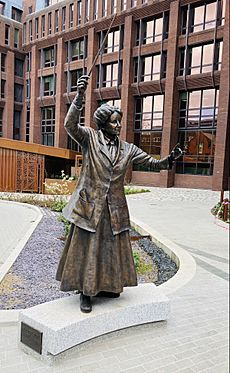
- Lady Margaret Beaufort (c. 1441–1509), mother of Henry VII – lived at Woking Palace.
- Arthur Balfour, 1st Earl of Balfour (1848–1930), former Prime Minister – lived at Fisher's Hill.
- George Bernard Shaw (1856–1950), famous playwright – lived in Woking from 1901 to 1903.
- Ethel Smyth (1858–1944), composer and suffragette – lived at Coign, Hook Heath Road.
- H. G. Wells (1866–1946), writer of The War of the Worlds – lived in Maybury Road.
- Eric Bedser (1918–2006) and Sir Alec Bedser (1918–2010), twin-brother cricketers – lived in Woking most of their lives.
- Delia Smith (b. 1941), celebrity chef and TV presenter – was born in Woking.
- Ron Dennis (b. 1947), founder of McLaren Group – was born and lives in Woking.
- Sean Lock (1963–2021), comedian – grew up in Woking.
- Paul Weller (b. 1958), singer-songwriter and musician – was born in Woking.
See also
 In Spanish: Woking para niños
In Spanish: Woking para niños


